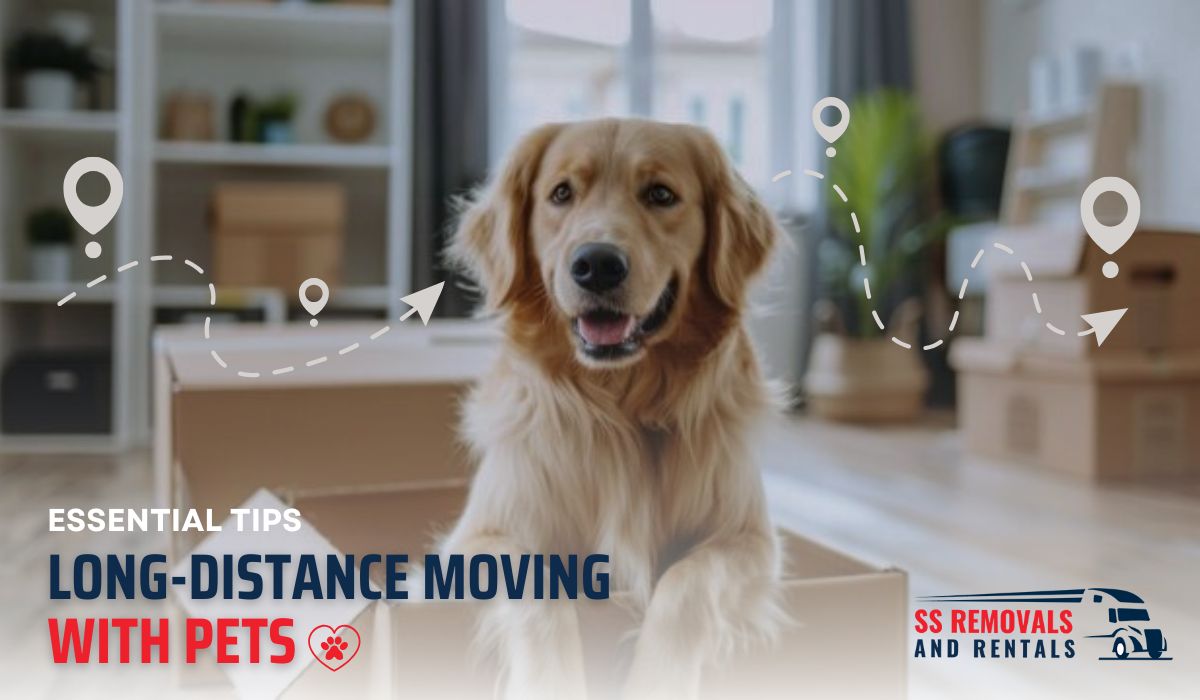Imagine the scene: boxes stacked high, the hum of a moving truck, and your furry friend looking at you with those big, questioning eyes. Moving is stressful enough for humans, but it can be a whirlwind of anxiety and confusion for our pets. Did you know that a significant percentage of pet owners consider their pets’ needs a primary concern during a move? It’s a common worry, and you’re not alone. Long distances, unfamiliar environments, and disruptions to routine can be particularly challenging for pets.
However, with careful planning and preparation, you can make the transition as smooth and stress-free as possible for both you and your beloved companion. This comprehensive guide will walk you through a step-by-step process to ensure a successful long-distance move with your pets.
Pre-Move Planning
Planning is Paramount: Start Early!
Don’t wait until the last minute! Begin planning your pet’s move as soon as you know you’re relocating.
- Veterinary Check-up: Schedule a visit with your vet. Ensure your pet is healthy enough for travel and obtain necessary health certificates, vaccination records, and medications.
- Microchipping and ID Tags: Verify your pet’s microchip information is up-to-date and ensure they have a sturdy collar with an ID tag containing your current contact details and new address.
- Travel Arrangements: Research airline or ground transportation options well in advance. Some airlines have breed restrictions, and ground transport can book up quickly.
- Accommodation Research: If you’ll be staying in hotels or temporary housing, confirm their pet policies and availability.
- New Vet Search: Start looking for a new veterinarian in your destination city.
Travel Options: Choosing the Best Route
The best travel option depends on your pet’s size and temperament and the distance of the move.
- Car Travel: For shorter distances, driving is often the most comfortable option. Ensure your pet is securely restrained in a carrier or harness. Make frequent stops for bathroom breaks, food, and water.
- Air Travel: If flying, research airline pet policies carefully. Consider your pet’s breed, size, and health. Some breeds are not allowed to fly in cargo due to health risks.
- Professional Pet Transport: For long distances or if you’re unable to travel with your pet, consider a professional pet transport service. These companies specialize in safely transporting animals and can handle all the logistics.
Packing for Your Pet: Essentials for a Smooth Journey
Prepare a pet travel kit with all the essentials your furry friend will need during the move.
- Food and Water: Pack enough of your pet’s regular food and water for the entire trip, plus extra in case of delays.
- Medications and Medical Records: Keep all medications and medical records in a waterproof bag and easily accessible.
- Comfort Items: Include familiar items like blankets, toys, and bedding to help your pet feel secure.
- Litter Box/Waste Bags: If traveling with a cat or dog, pack a portable litter box or waste bags for bathroom breaks.
- First-Aid Kit: Pack a pet-specific first-aid kit in case of minor injuries.
- Travel Carrier: Ensure your pet’s carrier is properly sized and ventilated.
Acclimating to the New Home: Making the Transition Easier
Moving to a new environment can be stressful for pets. Help them adjust by creating a safe and comfortable space.
- Introduce Gradually: Allow your pet to explore their new home gradually, starting with one room at a time.
- Maintain Routine: Stick to your pet’s regular feeding and walking schedule as much as possible.
- Provide Comfort: Offer familiar items and plenty of love and attention.
- Supervise Closely: Supervise your pet closely, especially in the first few weeks, to prevent them from escaping or getting lost.
- Address Anxiety: If your pet is showing signs of anxiety, consult your veterinarian for advice on calming techniques or medication.
Additional Tips for a Stress-Free Move:
- Hydration is Key: Ensure your pet stays hydrated throughout the journey. Offer water frequently and consider using a travel water bowl.
- Temperature Control: Be mindful of temperature extremes, especially during air travel or car rides.
- Safety First: Never leave your pet unattended in a vehicle, especially in hot weather.
- Be Patient: Moving is stressful for pets, so be patient and understanding during the adjustment period.
- Storage Solutions: If you need temporary storage for your belongings, consider pet-friendly storage options.
- Local Laws: Research any local animal laws in your new area, such as leash laws or licensing requirements.
Travel Day Strategies
Preparing for the Journey:
- Feeding and watering guidelines before travel: Follow your vet’s guidelines for feeding and watering before travel.
- Exercise before departure: Provide ample exercise before departure to help your pet relax.
- Creating a calm and comfortable environment: Create a calm and comfortable environment in the car or carrier.
Driving with Pets:
- Securely restraining pets in the car: Securely restrain your pets in the car using a harness or carrier.
- Regular stops for potty breaks and exercise: Make regular stops for potty breaks and exercise.
- Maintaining a comfortable temperature: Maintain a comfortable temperature in the car.
- Never leave pets alone in a vehicle: Never leave pets alone in a vehicle, especially in extreme temperatures.
Flying with Pets:
- Airline regulations and requirements: Adhere to airline regulations and requirements for pet travel.
- Preparing the travel crate: Prepare the travel crate according to airline specifications.
- Minimizing stress during travel: Minimize stress during travel by providing comfort and reassurance.
- Arrival procedures: Follow arrival procedures carefully.
Managing Pet Anxiety:
- Calming aids and techniques: Use calming aids and techniques, such as pheromone sprays or calming treats, if necessary.
- Maintaining a consistent routine: Maintain a consistent routine as much as possible.
- Providing comfort and reassurance: Provide comfort and reassurance throughout the journey.
Moving with Pets: Species-Specific Tips
Dogs:
- Desensitization:
- Gradually introduce moving boxes, dollies, and their travel crate.
- Associate these items with positive experiences (treats, praise).
- Maintain Routine:
- Stick to regular feeding and potty break schedules.
- Exercise and Mental Stimulation:
- Provide ample physical activity to reduce anxiety.
- Offer engaging toys (e.g., stuffed Kong, treat ball) during crate time.
Cats:
- Carrier Acclimation:
- Familiarize your cat with their carrier by feeding them meals inside it.
- Litter Provisions:
- Pack their litter, litter pan, and scooper for travel.
- Stress Reduction:
- Use pheromone products (e.g., Feliway sprays or collars) to minimize stress during the move.
Moving with Birds:
- Stress Management:
- Monitor for changes in feathers, appetite, and behavior.
- Keep the bird close during the move.
- Car Travel:
- Place carrier in the backseat (to avoid airbag injury).
- Maintain a stable temperature.
- Use a blanket to shield the area from direct sunlight.
Moving with Reptiles:
- Air Travel (Avoid if Possible):
- Air travel is highly stressful.
- If necessary, use airline-approved cargo carriers.
- Inspect cargo hold conditions (pressurization, temperature).
- Carrier Specifics:
- Larger reptiles may travel in pet carriers.
Moving with Fish:
- Water Transport:
- Use 5-gallon containers with aquarium water.
- Consult an aquatic vet about water supplements or sedation.
- Environment:
- Keep the environment dark and cool.
- Minimize transport time.
- Arrival:
- Set up the aquarium immediately upon arrival.
- The aquarium must be prepared before fish are placed into the water.
Moving with pets requires extra planning, but the reward of having your furry companions safely by your side is well worth the effort. By following these tips, you can minimize stress and ensure a smooth transition for everyone. Happy travels!
For expert assistance with your long-distance move, trust SS Removals and Rentals to provide seamless relocation solutions for you and your pets. Our team understands the challenges of moving with animals and is here to help ensure a stress-free transition. Contact us today at 0450 203 763 to learn more about our services and how we can make your move easier.



